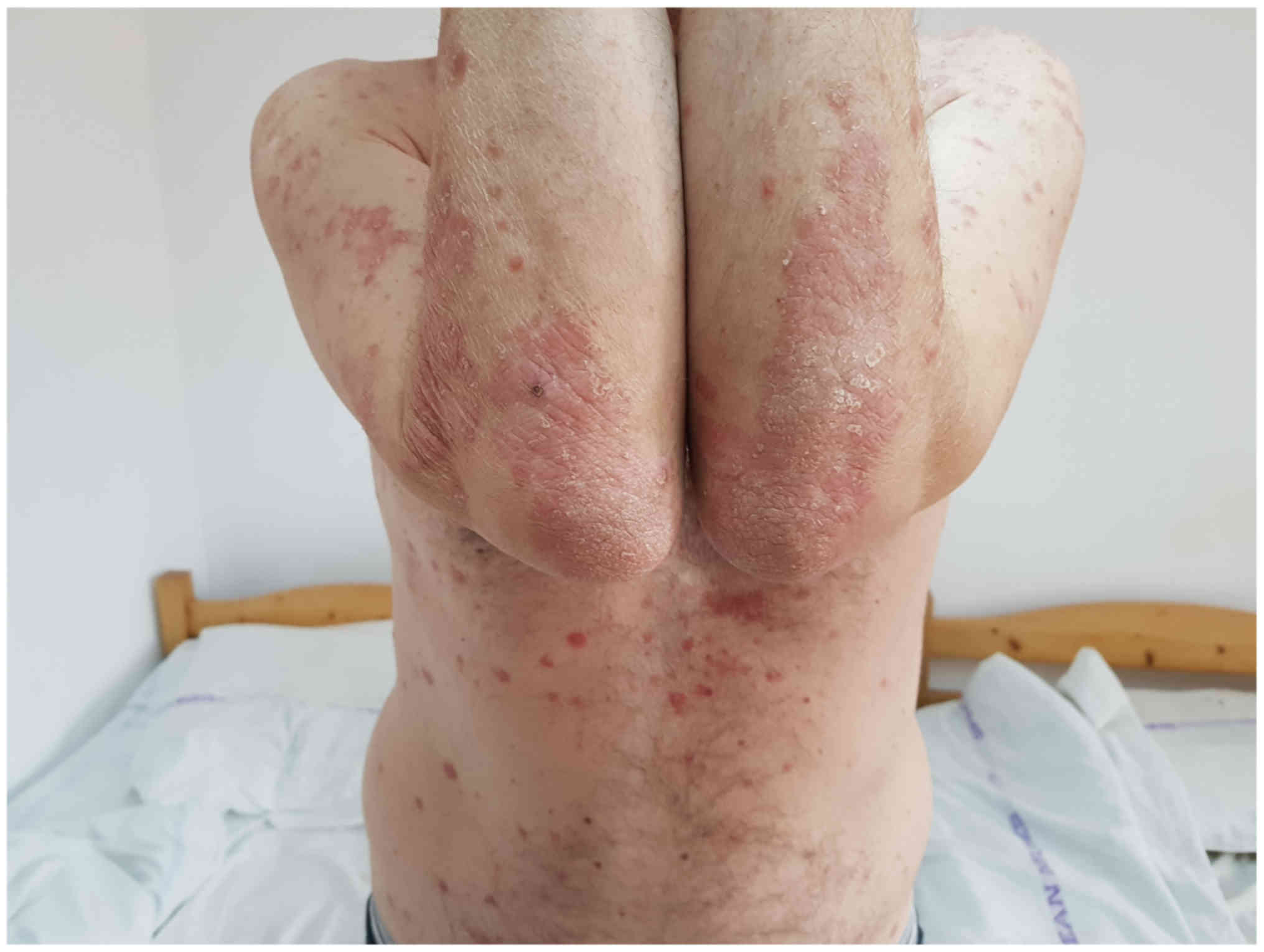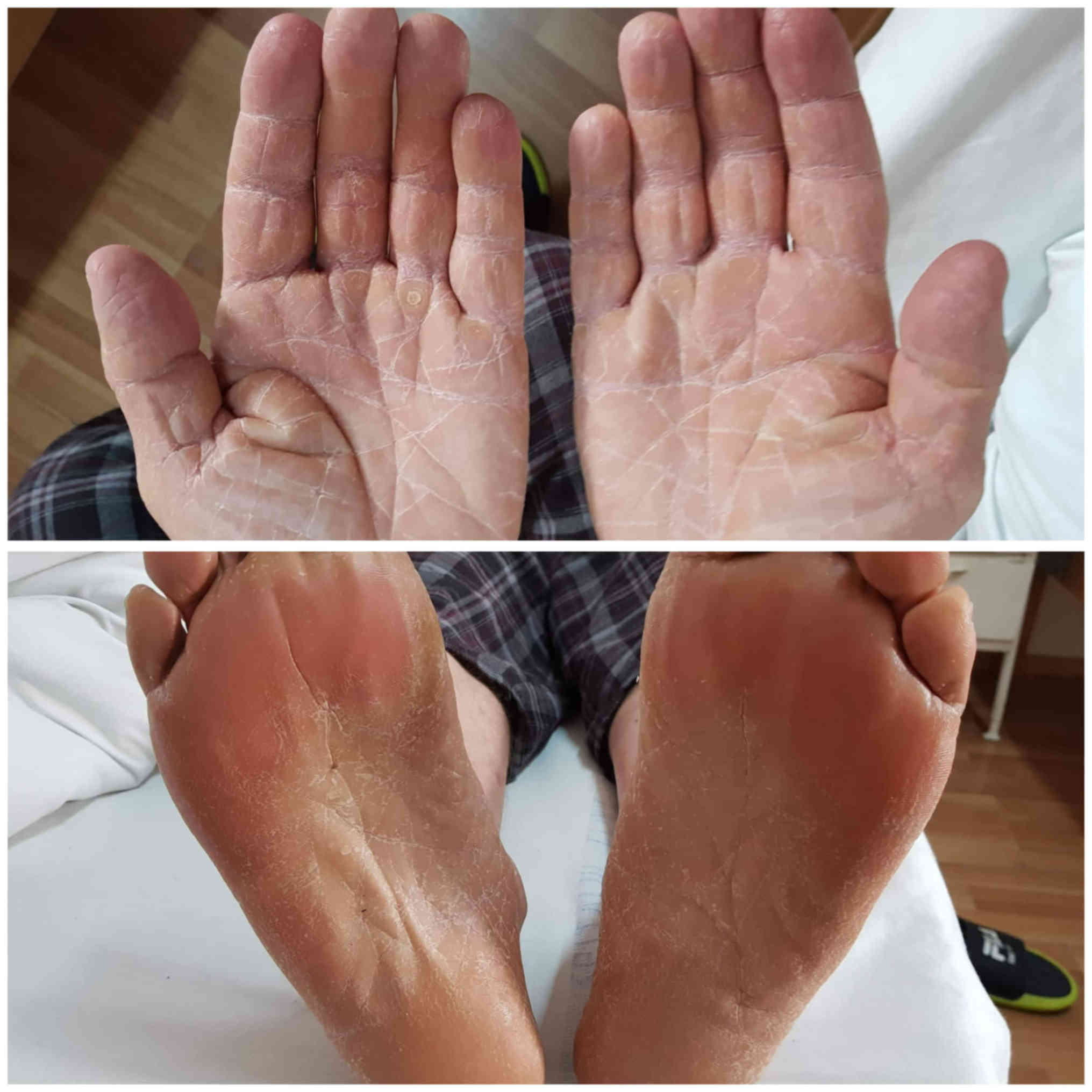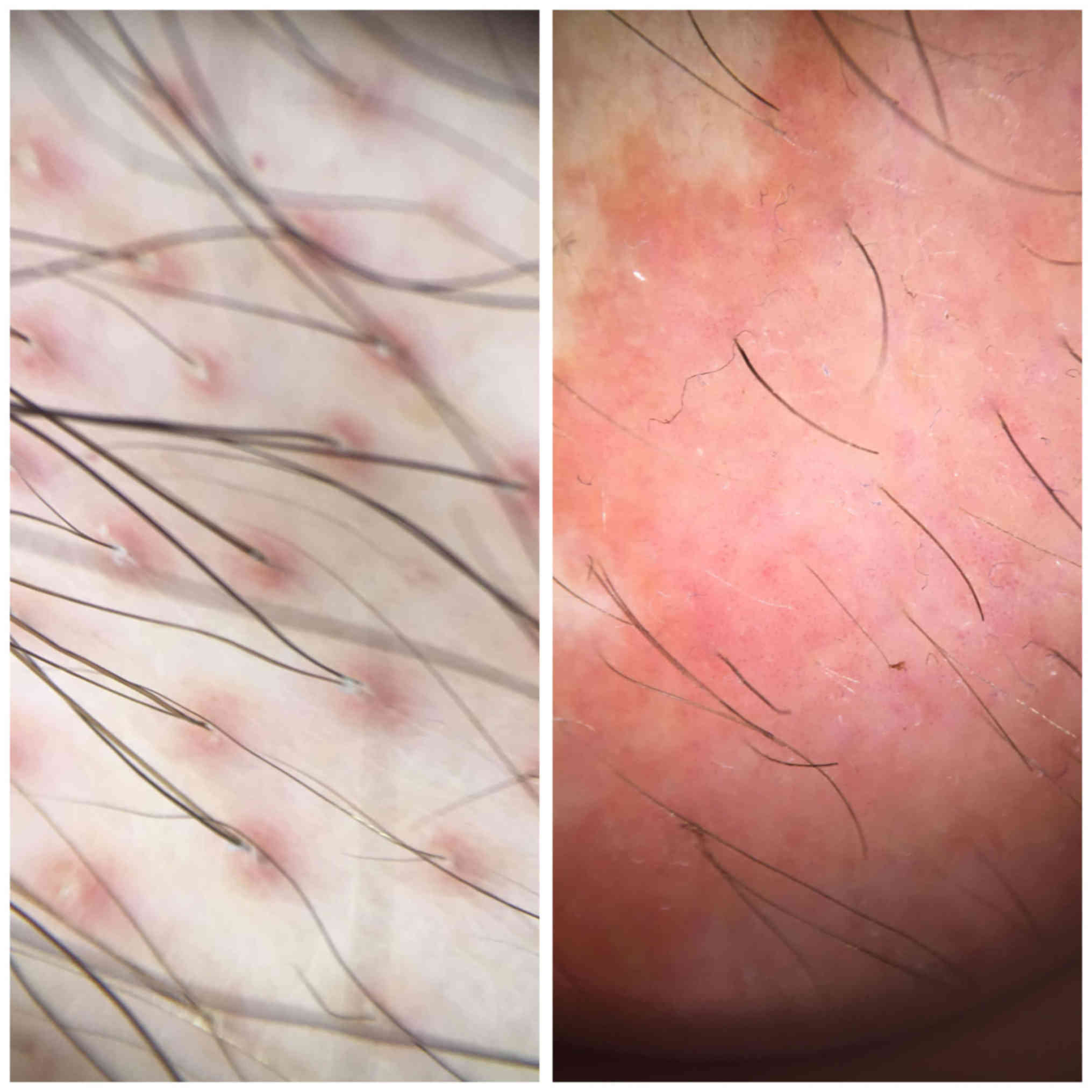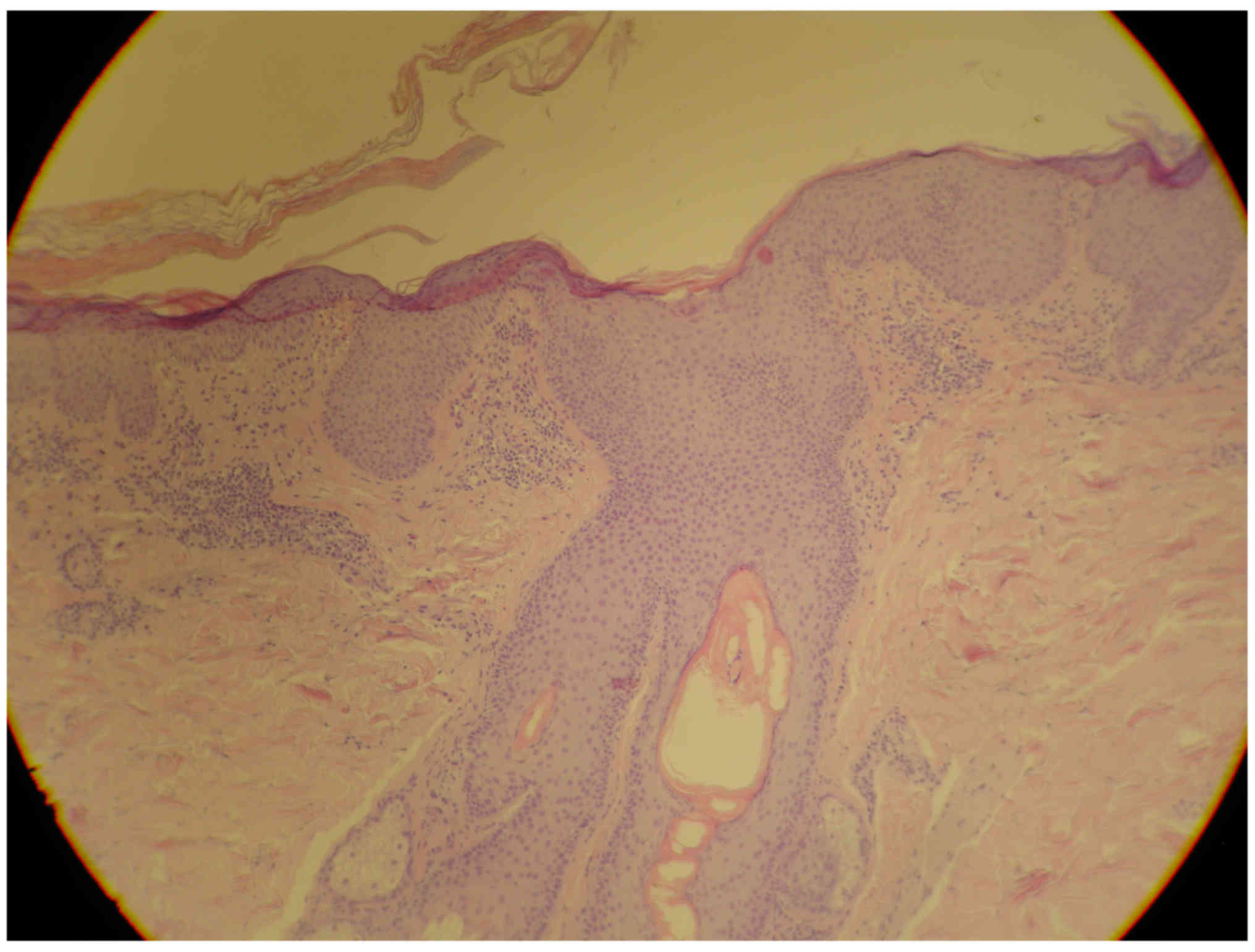|
1
|
Wang D, Chong VC, Chong WS and Oon HH: A
review on pityriasis rubra pilaris. Am J Clin Dermatol. 19:377–390.
2018. View Article : Google Scholar : PubMed/NCBI
|
|
2
|
Batinac T, Kujundzić M, Peternel S,
Cabrijan L, Troselj-Vukić B and Petranović D: Pityriasis rubra
pilaris in association with laryngeal carcinoma. Clin Exp Dermatol.
34:e917–e919. 2009. View Article : Google Scholar : PubMed/NCBI
|
|
3
|
Griffiths WA: Pityriasis rubra pilaris.
Clin Exp Dermatol. 5:105–112. 1980. View Article : Google Scholar : PubMed/NCBI
|
|
4
|
Auffret N, Quint L, Domart P, Dubertret L,
Lecam JY and Binet O: Pityriasis rubra pilaris in a patient with
human immunodeficiency virus infection. J Am Acad Dermatol.
27:260–261. 1992. View Article : Google Scholar : PubMed/NCBI
|
|
5
|
Blauvelt A, Nahass GT, Pardo RJ and Kerdel
FA: Pityriasis rubra pilaris and HIV infection. J Am Acad Dermatol.
24:703–705. 1991. View Article : Google Scholar : PubMed/NCBI
|
|
6
|
Martin AG, Weaver CC, Cockerell CJ and
Berger TG: Pityriasis rubra pilaris in the setting of HIV
infection: Clinical behaviour and association with explosive cystic
acne. Br J Dermatol. 126:617–620. 1992. View Article : Google Scholar : PubMed/NCBI
|
|
7
|
Miralles ES, Núñez M, De Las Heras ME,
Pérez B, Moreno R and Ledo A: Pityriasis rubra pilaris and human
immunodeficiency virus infection. Br J Dermatol. 133:990–993. 1995.
View Article : Google Scholar : PubMed/NCBI
|
|
8
|
Bar-Ilan E, Gat A, Sprecher E and Zeeli T:
Paraneoplastic pityriasis rubra pilaris: Case report and literature
review. Clin Exp Dermatol. 42:54–57. 2017. View Article : Google Scholar : PubMed/NCBI
|
|
9
|
Remedios IM, Jensen JD, Beckum K, McKay K
and Kissel R: Paraneoplastic pityriasis rubra pilaris as the
presenting manifestation of metastatic squamous cell carcinoma. J
Drugs Dermatol. 13:610–612. 2014.PubMed/NCBI
|
|
10
|
Kurzydlo AM and Gillespie R:
Paraneoplastic pityriasis rubra pilaris in association with
bronchogenic carcinoma. Australas J Dermatol. 45:130–132. 2004.
View Article : Google Scholar : PubMed/NCBI
|
|
11
|
Garretson CB, Machan ML, Krejci-Manwaring
J, Aires D and Tonkovic-Capin V: Letter: Adenocarcinoma of the lung
associated with pityriasis rubra pilaris. Dermatol Online J.
17:14–17. 2011.PubMed/NCBI
|
|
12
|
Sánchez-Regaña M, López-Gil F, Salleras M
and Umbert P: Pityriasis rubra pilaris as the initial manifestation
of internal neoplasia. Clin Exp Dermatol. 20:436–438. 1995.
View Article : Google Scholar : PubMed/NCBI
|
|
13
|
Batchelor RJ, Yung A, Merchant W and
Goodfield MJ: Pityriasis rubra pilaris as the initial presentation
of renal cell carcinoma? Clin Exp Dermatol. 30:442–443. 2005.
View Article : Google Scholar : PubMed/NCBI
|
|
14
|
Sharma S, Weiss GR and Paulger B:
Pityriasis rubra pilaris as an initial presentation of
hepatocellular carcinoma. Dermatology. 194:166–167. 1997.
View Article : Google Scholar : PubMed/NCBI
|
|
15
|
Reinhardt LA and Rosen T: Pityriasis rubra
pilaris as the initial manifestation of leukemia. Cutis.
31:100–102. 1983.PubMed/NCBI
|
|
16
|
Roger J, Burg G, Miller K and Lanz U:
Pityriasis rubra pilaris-artiges Vorstadium eines Sezary-Syndroms.
Syndroms (Pityriasis rubra pilaris the precursor of a Sezaryís
syndrome). Z Hautkr. 66:1046–1050. 1991.(In German).
|
|
17
|
Tannenbaum CB, Billick RC and Srolovitz H:
Multiple cutaneous malignancies in a patient with pityriasis rubra
pilaris and focal acantholytic dyskeratosis. J Am Acad Dermatol.
35:781–782. 1996. View Article : Google Scholar : PubMed/NCBI
|
|
18
|
Huynh NT, Hunt MJ, Cachia AR and Veness
MJ: Merkel cell carcinoma and multiple cutaneous squamous cell
carcinomas in a patient with pityriasis rubra pilaris. Australas J
Dermatol. 43:48–51. 2002. View Article : Google Scholar : PubMed/NCBI
|
|
19
|
Abdel-Azim NE, Ismail SA and Fathy E:
Differentiation of pityriasis rubra pilaris from plaque psoriasis
by dermoscopy. Arch Dermatol Res. 309:311–314. 2017. View Article : Google Scholar : PubMed/NCBI
|
|
20
|
Price L and Lesesky E: Pityriasis rubra
pilaris and severe hypereosinophilia. Cutis. 100:E6–E7.
2017.PubMed/NCBI
|
|
21
|
Fekete GL, Cotoi OS and Fekete JE:
Multiple nodular cutaneous metastases as the first clinical sign of
signet ring cell gastric carcinoma: Case report. Acta
Dermatovenerol Croat. 20:34–37. 2012.PubMed/NCBI
|
|
22
|
Neagu M, Caruntu C, Constantin C, Boda D,
Zurac S, Spandidos DA and Tsatsakis AM: Chemically induced skin
carcinogenesis: Updates in experimental models (Review). Oncol Rep.
35:2516–2528. 2016. View Article : Google Scholar : PubMed/NCBI
|
|
23
|
Boda D: Cellomics as integrative omics for
cancer. Curr Proteomics. 10:237–245. 2013. View Article : Google Scholar
|
|
24
|
Neagu M, Constantin C, Tanase C and Boda
D: Patented biomarker panels in early detection of cancer. Recent
Pat Biomark. 1:10–24. 2011. View Article : Google Scholar
|




















